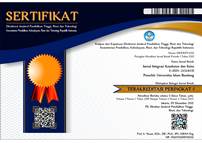Pengaruh Fraksi Jahe Gajah terhadap Kadar HDL dan LDL Mencit Model Dislipidemia
Abstract
Penyakit tidak menular (PTM) yang menjadi penyebab kematian nomor satu setiap tahunnya adalah penyakit kardiovaskular dengan salah satu faktor risiko dislipidemia. Dislipidemia ditandai dengan peningkatan kadar LDL dan penurunan HDL. Salah satu bahan tradisonal yang digunakan sebagai terapi dislipidemia adalah jahe gajah (Zingiber officinale). Senyawa flavonoid pada jahe gajah memiliki kandungan antioksidan dan menekan aktivitas enzim HMG-CoA reduktase sehingga memiliki efek terhadap profil lipid tubuh. Tujuan penelitian ini mengetahui pengaruh fraksi air jahe gajah terhadap kadar HDL dan LDL pada mencit model dislipdemia. Penelitian dilaksanakan di Laboratorium Hewan Farmasi Institut Teknologi Bandung dan Laboratorium Hewan Fakultas Kedokteran Universitas Islam Bandung periode April–Juni 2018. Penelitian eksperimental ini menggunakan 15 ekor mencit jantan tua (45–49 minggu) yang terbagi menjadi 5 kelompok. Kelompok kontrol positif diberikan pakan standar dan pelarut fraksi, kelompok kontrol negatif diberikan pakan tinggi lemak dan pelarut fraksi, kelompok perlakuan 1 diberikan fraksi air jahe gajah 19,9 mg/20 gBB/hari, kelompok perlakuan 2 diberikan fraksi air jahe gajah 39,8 mg/20 gBB/hari, dan kelompok perlakuan 3 diberikan fraksi air jahe gajah 79,6 mg/20 gBB/hari. Perlakuan dilakukan selama 28 hari. Hasil rerata kadar HDL setelah perlakuan adalah: 54,33 mg/dL; 35,00 mg/dL; 79,00 mg/dL; 81,57 mg/dL; dan 79, 67 mg/dL, sedangkan rerata kadar LDL adalah 6,53 mg/dL; 11,67 mg/dL; 33,33 mg/dL; 35,00 mg/dL, dan 21,33 mg/dL. Analisis statistik dengan one-way ANOVA pada pengukuran HDL bermakna signifikan (p<0,05) dan pengukuran LDL tidak signifikan (p>0,05) kelompok perlakuan dengan kelompok kontrol positif dan negatif. Hasil penelitian ini menunjukkan pengaruh fraksi air jahe gajah terhadap kadar HDL namun tidak terdapat pengaruh terhadap kadar LDL.
THE EFFECT OF GINGER FRACTION ON HDL AND LDL LEVELS IN MICE WITH DYSLIPIDEMIA
The main cause of death among non-communicable diseases every year is cardiovascular disease, with one of the risk factors is dyslipidemia. Dyslipidemia is characterized by increased levels of LDL and decreased HDL. Ginger (Zingiber officinale) is one of the traditional herbs used as a therapy in dyslipidemia. Flavonoid compounds in ginger contain antioxidants and suppress the activity of the enzyme HMG-CoA reductase that it has an effect on the body’s lipid profile. The purpose of this study was to determine the effect of ginger fraction on HDL and LDL levels in mice with dyslipidemia. This experimental study used 15 old male mice (45–49 weeks). Mice are divided into 5 groups. The positive control group was given standard diet and fraction solvents, the negatif control group was given high fat diet and fraction solvents, the group 1 was given the ginger fraction 19.9 mg/20gBB/day, the group 2 was given ginger fraction 39.8 mg/20 gBB/day, and the group 3 was given a fraction of ginger 79.6 mg/20 gBB/day. The treatment was carried out for 28 days. The average of HDL levels was: 54.33 mg/dL; 35.00 mg/dL; 79.00 mg/dL: 81.57 mg/dL; and 79, 67 mg/dL. While the average of LDL was 6.53 mg/dL; 11.67 mg/dL; 33.33 mg/dL; 35.00 mg/dL, and 21.33mg/dL. Statistical analysis with one-way ANOVA on HDL measurements was significant (p <0.05) and non-significant LDL measurements (p> 0.05) between treatment group and control groups. The conducted study showed an effect of the ginger water fraction on HDL levels and no effect on LDL levels.Keywords
Full Text:
PDFReferences
Kementerian, Badan Litbangkes. Situasi kesehatan jantung-Info Datin. Jakarta: Kementerian Kesehatan RI; 2014.
WHO. Cardiovascular diseases (CVDs). Jenewa Swiss: WHO; 2017
Perhimpunan Dokter Spesialis Kardiovaskular Indonesia. Pedoman tatalaksana dislipidemia. Jakarta: Centra Communications; 2013.
Ramkumar S, Raghunath A, Raghunath S. Statin therapy: review of safety and potential side effects. Acta Cardiologica Sinica. 2016 Nov;32(6):631–9.
Kementerian Perdagangan RI. Obat herbal tradisional. Warta Ekspor September 2014. Jakarta: Kemendag; 2014.
Gholib D. Uji daya hambat ekstrak etanol jahe merah (Zingiber officinale var. Rubrum) dan jahe putih (Zingiber officinale var. Amarum) terhadap trichophyton mentagrophytes dan Cryptococcus neoformans. Semin Nas Teknol Peternakan Veteriner. 2008:827–30.
Adnyana IK, Suciyati SW. Napak tilas jahe gajah (Zingiber officinale roscoe var officinale) dan jahe merah (Zingiber officinale var rubrum). J Farmasi Galenika. 2016;3(1):1–7.
Rifai N, Warnick R, Dominiczak MH. Handbook of lipoprotein testing. Edisi ke-2. Washington DC: AACC Press; 2001.
Safitri D, Kurniati NF, Adharani S, Suciyati SW, Adnyana IK. The study of red ginger rhizomes ethanol extract (Zingiber officinale roscoe var. Sunti Val.) on hyperlipidemic-induced rats. PhOL. 2016;3:15–21.
Harvey R, Ferrier D. Lippincott’s illustrated reviews: biochemistry. Edisi ke-5. Philadelphia: Lippincott Williams & Wilkins, a Wolters Kluwer Business; 2011.
Al-Noory AS, Amreen AN, Hymoor S. Antihyperlipidemic effects of ginger extracts in alloxan-induced diabetes and propylthiouracil-induced hypothyroidism in (rats). Pharmacognosy Res. 2013 Jul;5(3):157–61. doi: 10.4103/0974-8490.112419.
Ekananda N. Bay leaf in dyslipidemia therapy. J Majority. 2015;4(4):64–9.
Sari RP, Rahayuningsih HM. Pengaruh pemberian jahe merah (Zingiber officinale var Rubrum) terhadap kadar kolesterol total wanita dislipidemia. J Nutr College Kedokteran Universitas Diponegoro. 2014;3(4):798–806.
Yulianti AB, Widayanti, Rahmawaty I. Efek proteksi campuran ekstrak bawang putih, jahe gajah, dan lemon terhadap kadar kolesterol total darah pada tikus tua yang terpapar diet tinggi lemak protective. Prosiding Seminar Nasional Penelitian dan PKM Kesehatan. 2017;3(1):215–21.
Jagetia G, Baliga M, Venkatesh P. Ginger (Zingiber officinale Rosc.), a dietary supplement, protects mice against radiation- induced lethality: mechanism of action. Cancer Biother Radiopharm. 2004;19(4):422–35.
Ningsih IY. Keamanan jamu tradisional. Modul saintifikasi jamu. Jember: Bagian Biologi Farmasi Fakultas Farmasi Universitas Jember; 2016.
DOI: https://doi.org/10.29313/jiks.v1i1.4324
Refbacks
- There are currently no refbacks.
Jurnal Integrasi Kesehatan dan Sains is licensed under a Creative Commons Attribution-NonCommercial-ShareAlike 4.0 International License.







.png)
_(1).png)





















